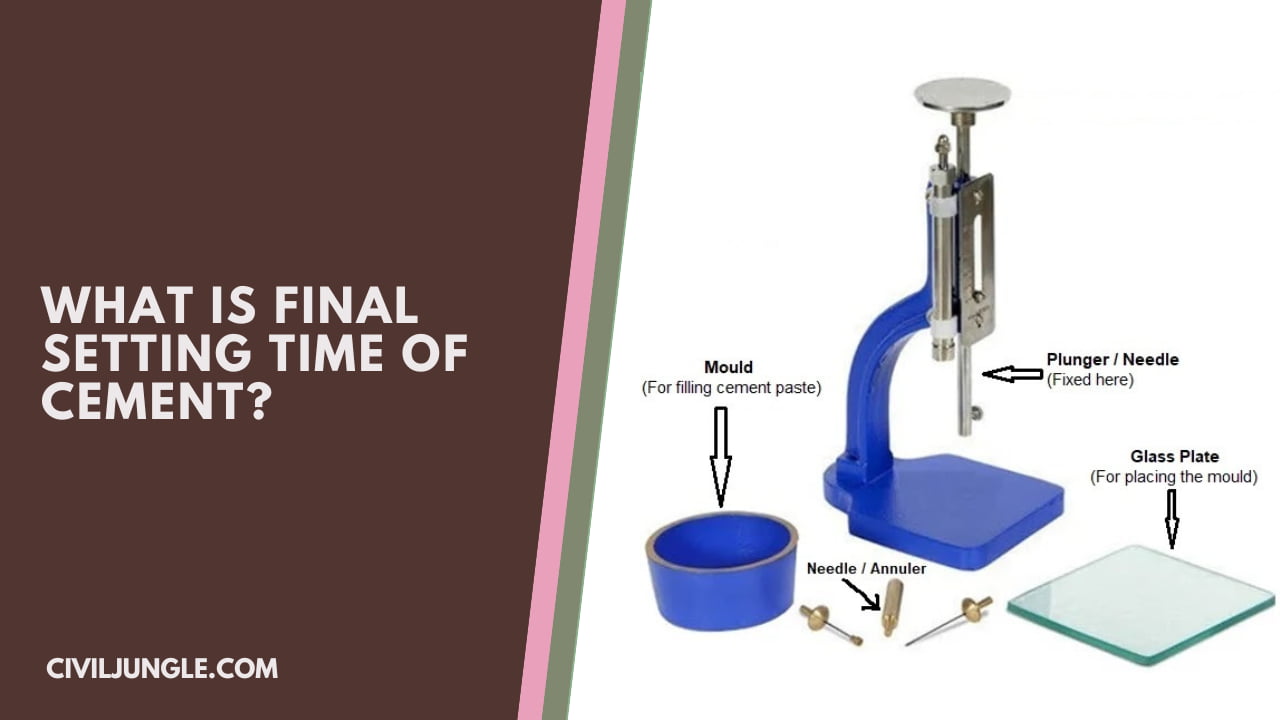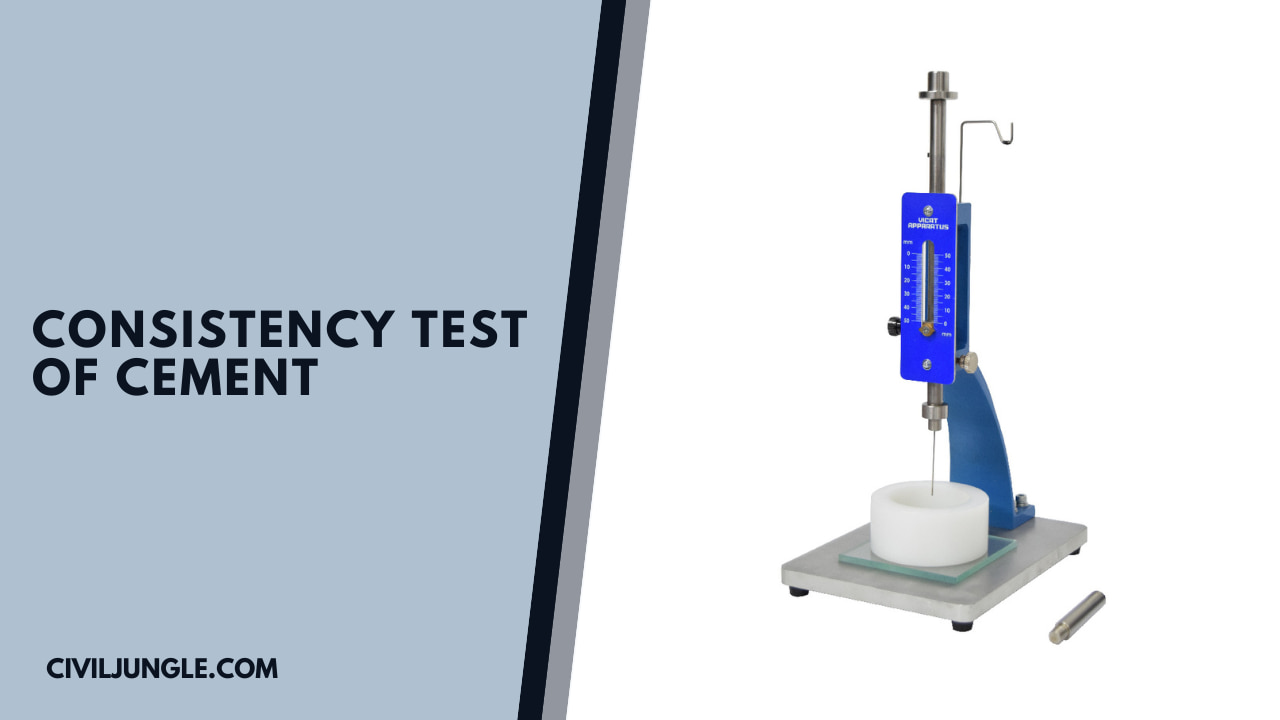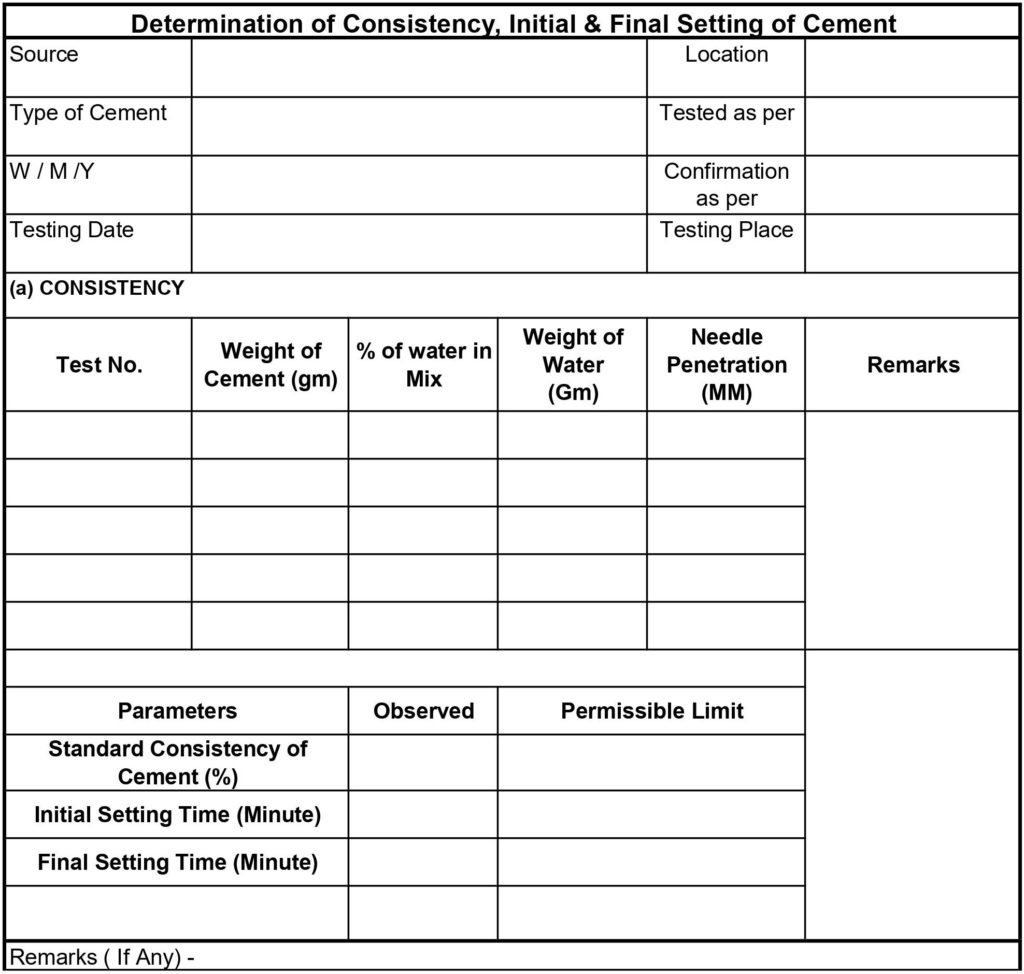What Is Consistency of Cement?
Important Point
Any Cement paste requirement of minimum water in cement paste for initiate the chemical reaction. This chemical reaction call the consistency of cement. This method call consistency fo cement test.
Relevant is code: IS code 4031 part 4 -Consistency of Standard Cement past
What Is Initial Setting Time of Cement?
Initial setting time of cement: Casting cement past in any mold without losing strength & Shape. This working prosses time call initial setting time of cement.
Also Read : CORE CUTTER METHOD
Determination of Initial Setting Time: from IS Code 4031 part 5, page no 2, cl 5.2
Place the test block confined in the mold and resting on the non-porous plate, under the rod bearing the needle ( C ); lower the needle gently until it comes in contact with the surface of the text block and quickly releases. From IS Code 4031 part 5
Allowing it to penetrate into the test block. In. The beginning, the needle will completely pierce the test block.
Repeat this procedure until the needle, when brought in contact with the test block and released as described above, fails to penetrate the block beyond 5.0 ± 0.5 mm measured from the bottom of the mold.
The period elapsing between the time when water is added to the cement and the time at which the needle fails to pierce the test block to a point 5.0 ± 0.5 mm measured from the bottom of the mold shall be the initial setting time.From IS Code 4031 part 5
Relevant is code: IS code 4031 part 5 Initial Setting time of Cement.
Normally Initial Setting Time :
O.P.C (Ordinary Portland Cement) 30 min.Initial Setting time of Cement
Rapid Cement 5 min Initial Setting time of Cement
Also Read :LAB TEST ON AGGREGATES AT SITE
What Is Final Setting Time of Cement?
Any cement paste stating time of Cement paste is loose cement past to going hard shape of cement pest. All complete prosses of Cement Harding final time call final setting time of cement.
Determination of Final Setting Time: from IS Code 4031 part 5, page no 2, cl 5.3
Replace the needle ( C ) of the Vicat apparatus by the needle with an annular attachment ( F ). The cement shall be considered as finally set whenFrom IS Code 4031 part 5
Upon applying the needle gently to the surface of the text test block, the needle makes an impression thereon, while the attachment fails to do so.From IS Code 4031 part 5
The period elapsing between the time when water is added to the cement and the time at which the needle makes an impression on the surface of test block while the attachment fails to do so shall be the final setting time.
In the event of a scum forming on the surface of the test block, use the underside of the block for the determination
Relevant is code: IS code 4031 part 5 Final Setting time of Cement.
Also Read : PROCEDURE FOR RCC CONCRETE
Consistency Test of Cement
Aim for Consistency Test of Cement:
To determine the standard consistency of test of Cement
Scope for Consistency Test of Cement:
This procedure covers all relative activity for the project site.
Apparatus of Consistency Test of Cement:
#a. Vicat’s Apparatus
Vicat apparatus conforming from IS: 5513-1976
#b. Plunger
#c. Balance.
#d. Measuring cylinder
#e. Non-Porous Plate
Sample:
#a. Cement
Also read: SOUNDNESS OF CEMENT TEST
Procedure for Consistency Test of Cement :
- Take about 500 gms cement and prepare a paste with a weight quantity of water (say 24 percent by weight of cement) for the first trial.
- The paste must be made in a conventional manner and filled into the Vicat mold within 3-5 minutes.
- After complete filling, the mold shakes the mold to expel air.
- A standard plunger 10mm diameter, 50mm long is attached and brought down to touch the surface of the paste in the test block & quickly released, allowing it to sink into the paste by its own weight.
- Take the reading this reading note down the depth of penetration of the plunger.
- Conduct a 2nd trial (say with 25 percent of water) and find out the depth of penetration of plunger. Similarly,
- Conduct trials with higher water/cement ratio till such time of plunger penetrates a depth of 33-35 mm from the top.
- That particular percentage of water maximum allows the plunger to percentage only to a depth 33-35mm from the top is known as the %(percentage) of the water required to produce the cement paste of standard consistency.
- The test is expected required to be conducted at a constant temperature (27°± 2°) C & constant humidity (90%)
Results of Consistency Test of Cement:
Express the amount of water as a % by weight of the dry cement
Also read : IS CODE FOR CIVIL ENGINEER [Q&A]
Sample Excel File Consistency, initial & Final setting of cement
Calculation for Consistency Test of Cement:
Express the amount of water as a percentage by mass of the dry cement to the first place of decimal.
Consistency of Cement
The standard consistency of cement is that consistency, which permits the Vicat plunger to penetrate to a point 5 to 7mm from the bottom of the Vicat mold when tested. The procedure to determine the quantity of water required to produce a cement paste of standard consistency is described below.
What Is Consistency of Cement
The consistency of cement paste is defined as the percentage of water requirement of cement paste at which the viscosity of paste in such a way that it determines the amount of water needed to make a paste. It is necessary to determine consistency because the amount of water affects the setting time of the cement.
Standard Consistency of Cement
The Standard or Normal consistency for Ordinary Portland cement varies between 25-35%. To prepare a mix of cement paste of Standard consistency 25-35% of water is added to the cement. To explain in detail Let us assume a standard consistency is 30%. Take 400g of Cement for this quantity, Add 30% of Water.
Setting Time of Cement
The time at which cement completely loses its plasticity and became hard is a final setting time of cement. The time taken by cement to gain its entire strength is a Final setting time of cement. For Ordinary Portland Cement, The Final Setting Time is 600 minutes (10hrs).
Final Setting Time of Cement
The time at which cement completely loses its plasticity and became hard is a final setting time of cement. The time taken by cement to gain its entire strength is a Final setting time of cement. For Ordinary Portland Cement, The Final Setting Time is 600 minutes (10hrs).
Setting Time Test of Cement
Record the period elapsed between the time of adding water to the cement to the time when the needle fails to pierce the mold by 5 + 0.5mm as the initial setting time. Final Setting Time
- Replace the needle of the Vicat apparatus by needle with an annular ring
- Lower the needle and quickly release.
Initial and Final Setting Time of Cement Test
The initial setting time is the exact moment when the concrete starts to harden. In theory, this time starts as soon as the water is added to the cement. The final setting time is the moment the concrete has hardened enough so that a five-millimetre square needle no longer penetrates the surface.
Consistency of Cement Meaning
The consistency of cement paste is defined as the percentage of water requirement of cement paste at which the viscosity of paste in such a way that it determines the amount of water needed to make a paste. It is necessary to determine consistency because the amount of water affects the setting time of the cement.
What Is the Initial Setting Time of Cement?
The national standards prescribe that the initial setting time of Portland cement should not be earlier than 45 min and the final setting time should not be later than 6.5 h.
Consistency Test of Cement
Consistency test of cement is a standard test used to determine the amount of water required to produce a cement paste of standard consistency. It is an important test in the quality control of cement because the consistency of the cement paste affects its setting time, strength development, and other properties.
Standard Consistency of Cement
The standard consistency of cement is defined as the percentage of water required to produce a cement paste that has a penetration depth of 5 to 7 mm from the bottom of the Vicat mold. According to Indian Standards, the standard consistency of ordinary Portland cement (OPC) is 30%, which means that 30% of water by weight is required to produce a cement paste of standard consistency.
Consistency of Cement Is Determined by
The Vicat apparatus is used to determine the consistency of cement. It consists of a plunger, a movable rod weighing 300 g, graduated scale, non-porous plate, split mould and Vicat mould. The diameter of the plunger is 10mm and the length is 50mm. The graduate scale measures the depth of penetration.
Normal Consistency of Cement
The normal consistency of a cement paste is defined as that consistency (% of water) which will permit the vicat plunger to penetrate to a point 10 mm from the top of the vicatmould. The usual range of values being between 22 to 30 percent by weight of dry cement. Normal consistency is also called standard consistency.
Consistency of Concrete
The concrete should have a peanut butter-like consistency. It should not be soupy. If so, add a small amount of dry concrete to stiffen the mix. Nor should the mix be powdery.
Consistency of Cement Definition
The standard consistency of cement is defined as the consistency which will permit a Vicat plunger having 10mm diameter and 50mm length to penetrate to a depth of 33-35 mm from the top of the mould. The Apparatus used is called Vicat Apparatus.
Define Consistency of Cement
Consistency of cement refers to the ability of cement paste to flow and retain its shape without segregating or bleeding. In simpler terms, it is the degree of stiffness or fluidity of the cement paste. The consistency of cement paste is determined by the amount of water added to it.
What Is Standard Consistency of Cement?
STANDARD • IS: 4031 (Part 4) 1988 DEFINITION • The standard consistency of a cement paste is defined as that consistency which will permit the vicat plunger to penetrate to a point 5 to 7mm from the bottom of the vicat mould.
Consistency of Cement Apparatus
One of the most common ways to assess cement consistency is with a Vicat apparatus. This machine is used to determine the standard consistency of a cement paste, as well as its initial and final setting time.
What Is Normal Consistency of Cement?
Normal consistency is the consistency of cement paste which allows penetration of the 10 mm diameter needle of Vicat plunger to 5 to 7 mm from the bottom of the standard Vicat apparatus. Normal consistency is also known as standard consistency of cement.
Consistency of Cement Test
The consistency of cement is an important property that determines its workability and ease of handling. The test for consistency of cement is known as the Vicat test, which involves measuring the amount of water required to produce a cement paste of standard consistency.
Cement Consistency
Cement consistency refers to the degree of wetness or dryness of the cement paste, which is determined by the water-cement ratio. The consistency of cement is an important property that affects the workability and strength of the concrete.
Like this post? Share it with your friends!
Suggested Read –
- Difference Between CPM and PERT | What Is CPM & PERT
- Hempcrete Vs Concrete | What Is Hempcrete | What Is Concrete
- Difference Between Veneer and Laminate | What Is Veneer | What Is Laminate
- Difference Between Compaction and Consolidation | What Is Compaction | What Is Consolidation
- PVB Vs SGP | What Is Limited Glass | What Is Polyvinyl Butyral (PVB) | What Is Sentry Glass Plus (SGP)
- BHK Full From | What Is BHK | What does 1BHK, 2BHK, 3BHK, 4 BHK, 2.5 BHK, 1 RK, 2 BHK 2T, 3 BHK 2T, 3 BHK 3T Mean
Originally posted 2023-04-28 17:40:41.












HI
Nice articular
Thanks, Pankaj